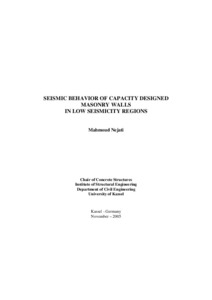| dc.date.accessioned | 2006-11-07T13:37:03Z | |
| dc.date.available | 2006-11-07T13:37:03Z | |
| dc.date.issued | 2006-11-07T13:37:03Z | |
| dc.identifier.uri | urn:nbn:de:hebis:34-2006110715516 | |
| dc.identifier.uri | http://hdl.handle.net/123456789/2006110715516 | |
| dc.format.extent | 10343560 bytes | |
| dc.format.mimetype | application/pdf | |
| dc.language.iso | eng | |
| dc.rights | Urheberrechtlich geschützt | |
| dc.rights.uri | https://rightsstatements.org/page/InC/1.0/ | |
| dc.subject | Gap Element | eng |
| dc.subject | Earthquake Engineering Masonry Structure | eng |
| dc.subject.ddc | 620 | |
| dc.title | Seismic behavior of capacity designed masonry walls in low seismicity regions | eng |
| dc.type | Dissertation | |
| dcterms.abstract | Eurocode 8 representing a new generation of structural design codes in Europe defines requirements for the design of buildings against earthquake action. In Central and Western Europe, the newly defined earthquake zones and corresponding design ground acceleration values, will lead in many cases to earthquake actions which are remarkably higher than those defined so far by the design codes used until now in Central Europe.
In many cases, the weak points of masonry structures during an earthquake are the corner regions of the walls. Loading of masonry walls by earthquake action leads in most cases to high shear forces. The corresponding bending moment in such a wall typically causes a significant increase of the eccentricity of the normal force in the critical wall cross section. This in turn leads ultimately to a reduction of the size of the compression zone in unreinforced walls and a high concentration of normal stresses and shear stresses in the corner regions.
Corner-Gap-Elements, consisting of a bearing beam located underneath the wall and made of a sufficiently strong material (such as reinforced concrete), reduce the effect of the eccentricity of the normal force and thus restricts the pinching effect of the compression zone. In fact, the deformation can be concentrated in the joint below the bearing beam. According to the principles of the Capacity Design philosophy, the masonry itself is protected from high stresses as a potential cause of brittle failure.
Shaking table tests at the NTU Athens Earthquake Engineering Laboratory have proven the effectiveness of the Corner-Gap-Element. The following presentation will cover the evaluation of various experimental results as well as a numerical modeling of the observed phenomena. | eng |
| dcterms.accessRights | open access | |
| dcterms.creator | Nejati, Mahmoud | |
| dc.contributor.corporatename | Kassel, Universität, FB 14, Bauingenieurwesen | |
| dc.contributor.referee | Fehling, Ekkehard (Prof. Dr.-Ing.) | |
| dc.contributor.referee | Jäger, Wolfram (Prof. Dr.-Ing.) | |
| dc.contributor.referee | Seim, Werner (Prof. Dr.-Ing.) | |
| dc.subject.swd | Mauerwerksbau | ger |
| dc.subject.swd | Erdbebenbelastung | ger |
| dc.subject.swd | Erdbebenzone | ger |
| dc.date.examination | 2005-11-24 | |

